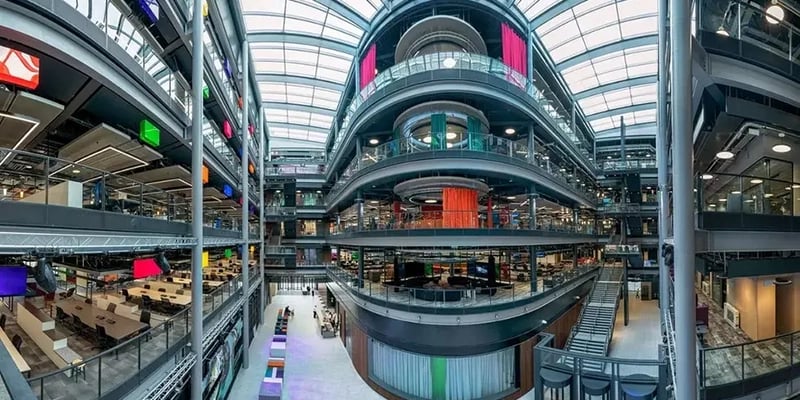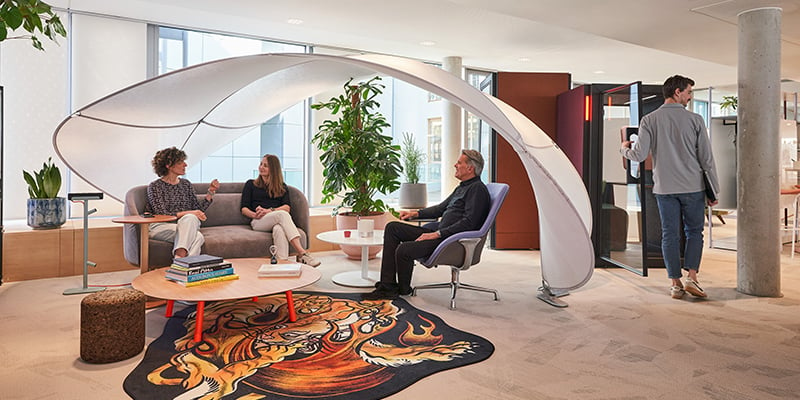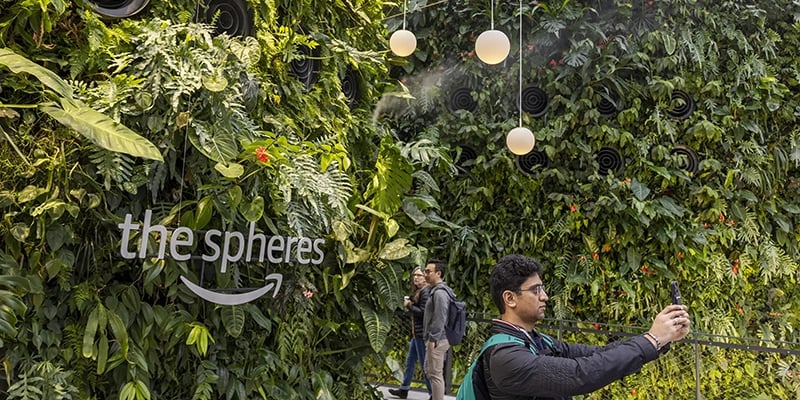In the ‘experience economy’ consumers want something more than material rewards for their labours. And in the same way, modern workers are looking for offices that reward them with enriching, collaborative and ‘cultural’ experiences that go beyond the everyday.
It was Gen Z and the Millennials who led the way in the experience economy - looking for the adventures that money couldn’t buy. Now they are demanding more from their workplaces, too.
And why wouldn’t they? Digital natives don’t need face-to-face processes to accomplish basic tasks, but they do need environments that can inspire, educate and make them feel like they belong.
5 destination offices where workers thrive
Here are 5 workplaces from around the world that reimagine offices as dynamic destinations where people can be together - and thrive together.
1. A social and cultural hub - Google
Google’s London office broke ground long before Covid, but it stands as a dramatic $1Billion statement of intent about the power of space to attract, retain and care for a productive and engaged workforce.
The vast office, ‘groundscraper’ features a rooftop running track, a swimming pool, gyms and landscaped garden - as well as a parade of retail space for shops and other businesses to occupy.
Healthy eating canteens, nap pods, massage services and a host of other wellbeing needs look after 4000 employees.
Social spaces, collaborative meeting rooms and presentation theatres create opportunities for different kinds of social and learning experiences.
Google’s ESG commitments are revealed in the building’s green credentials and the way they share their spaces with local entrepreneurs and community groups.
A single, suspended staircase runs from the ground floor to the top of the building, which the company says is designed to encourage interaction between employees.
“I think there really is a huge value in making sure we get that time together. The spontaneous nature of how people work and collaborate delivers a richness that’s difficult to do just through video conference.”
Rohan Harris Managing Director of Google UK
The building is about community in every sense - and how that offers opportunities to reinforce a culture of productivity - powered by face-to-face interaction, as well as technology.
The touches of personal care the building affords - and the way it stands in the heart of a vibrant mixed community - gives this giant workplace a human scale.
2. An inclusive hub - BBC New Broadcasting House
Making offices places where everyone can thrive is a huge part of the ‘destination office’ agenda. Designing offices to be comfortable and welcoming for everyone regardless of gender, race, orientation or disability maximises our ability to collaborate. Environments that favour one set of needs over another can make them unwelcoming and unworkable for many.
The ultimate destination office is capable of supporting everyone and encouraging all to use it effectively.
For example, the BBC's New Broadcasting House in Cardiff is built to accommodate all kinds of neurodiversive needs, in a striking building where movement and urgency can often be intense.

While 30% of spaces are traditional desks, the rest vary from high-stool benches to informal seating.
Multiple quiet zones and diverse meeting rooms cater to different sensory and privacy needs. Lighting is softer with LEDs replacing fluorescents.
Perhaps one of the simplest and most impactful changes we made was with lighting. Flickering lights are commonplace in office environments and can be a major hindrance. Non-flickering LED lamps and a drop in lighting levels – when compared to BCO (British Council of Offices) standards – are more welcoming and easier on the eyes.
Acoustics are tailored per space function. Patterns, especially on carpets, demarcate different zones, enhancing navigability for all (an overlooked issue for many neurodivergent people).
In this design everyone can find a space that works for them, while remaining part of a wider, busy and responsive team.
Our consultation process emphasised the importance of giving visitors and staff information about the experience of the building before arriving, allowing them to preview and prepare their journey, or plan the work setting that would suit them best.
3. A technological hub - The Edge
The Edge in Amsterdam was one of the earliest ‘destination offices’ when it was built in 2014.
“A day at the Edge in Amsterdam starts with a smartphone app developed with the building’s main tenant, consulting firm Deloitte. From the minute you wake up, you’re connected. The app checks your schedule, and the building recognises your car when you arrive and directs you to a parking spot.”
This ‘destination office’ occupied by Deloitte creates a bespoke and continually optimised experience for every occupant:
- Dynamic Workspaces: An app assigns workspaces based on your schedule, whether it's a sitting desk, standing desk, meeting room, or a "concentration room." No one has a fixed desk, promoting flexibility.
- Environmental Preferences: The app knows your preferences for light and temperature, adjusting the environment wherever you go.
- Connectivity: The LED panels are packed with sensors, creating a "digital ceiling" that makes the building responsive, behaving like a living organism.
- Locker System: Since there are no assigned desks, lockers serve as a base for the day. Employees can find a locker with a green light, flash their badge, and it's theirs.
- Building Interaction Data: Deloitte collects data on how the Edge and its employees interact, using dashboards to track everything from energy use to coffee machine refills.
Offices that use technology to help occupants maximise their performance are likely to win big in the future battle to recruit, retain and engage.
4. A training hub - LINC
Training spaces are pivotal for contemporary workforces. In fact, research says that learning and development is one of the key draws for millennials and Gen Z to return to the office.
Making the office fit to deliver these experiences in the 21st Century is one of the big challenges of the new world of office design.
Steelcases’s LINC building (Learning + Innovation Center) in Munich is a great example of building design that facilitates learning in a range of analogue and digital ways.

Its adaptable spaces seamlessly transform to suit diverse tasks, with agile furnishing supporting the needs of today's training activities where we move from group to individual exercises in quick succession.
LINC fosters collaboration through creating varied environments, from casual huddle areas to technologically advanced rooms and spaces for concentrated work.
5. A biophilic hub
Biophilic design is famously helping to improve workers’ experiences around the world. In Amazon Sphere’s in Seattle, this trend has seen its ultimate expression. Blending architecture with nature, the Spheres is a series of geodesic domes, where employees can escape into - and enjoy a multi-level jungle of exotic plants.

Amongst this tranquility - there is room to interact in new ways not afforded by a normal office. Banks of tables, secluded meeting nooks and benches distributed throughout the complex can seat up to 800 people - controlling acoustics and ensuring privacy at the same time.
Amazon envisions the building as a change of pace for its workers, a place to “feel differently, to think differently”.
Architect firm NBBJ designed the Spheres with a complex system to maintain the balance between a conservatory and workspace. The Spheres utilise recycled heat from a nearby data centre and have a coating on their glass panels to regulate light and heat. They also employ stadium lights to compensate for Seattle's dark winters.
Conclusion
Each of the designs we have selected showcases a different aspect of the importance of the ‘office as destination’.
They foreground the social, collaborative and wellness benefits of being in the same place at the same time. They demonstrate how digital and analogue design can dovetail to make us feel valued and cared for. And they say a lot about the priorities and missions of each organisation.
The care taken around their choices of tech, furnishing and space management, make powerful statements about each company’s commitment to their people and their business culture.
An office can be a destination in so many ways - but each business will need to build experiences tailored to their own workforces to reflect their own priorities, culture, vision and values.










